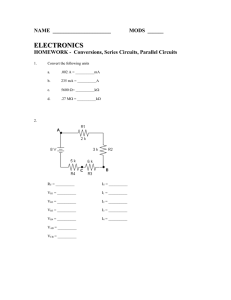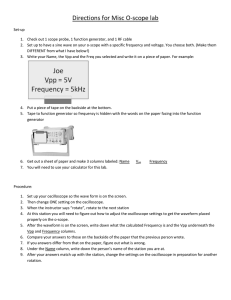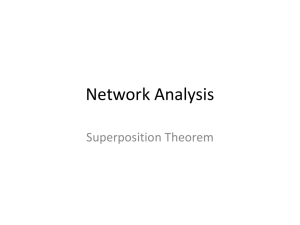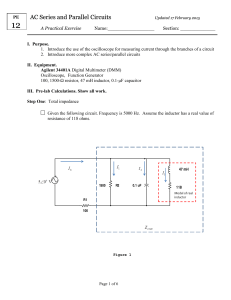03. Measuring the parameters of electrical quantities
advertisement
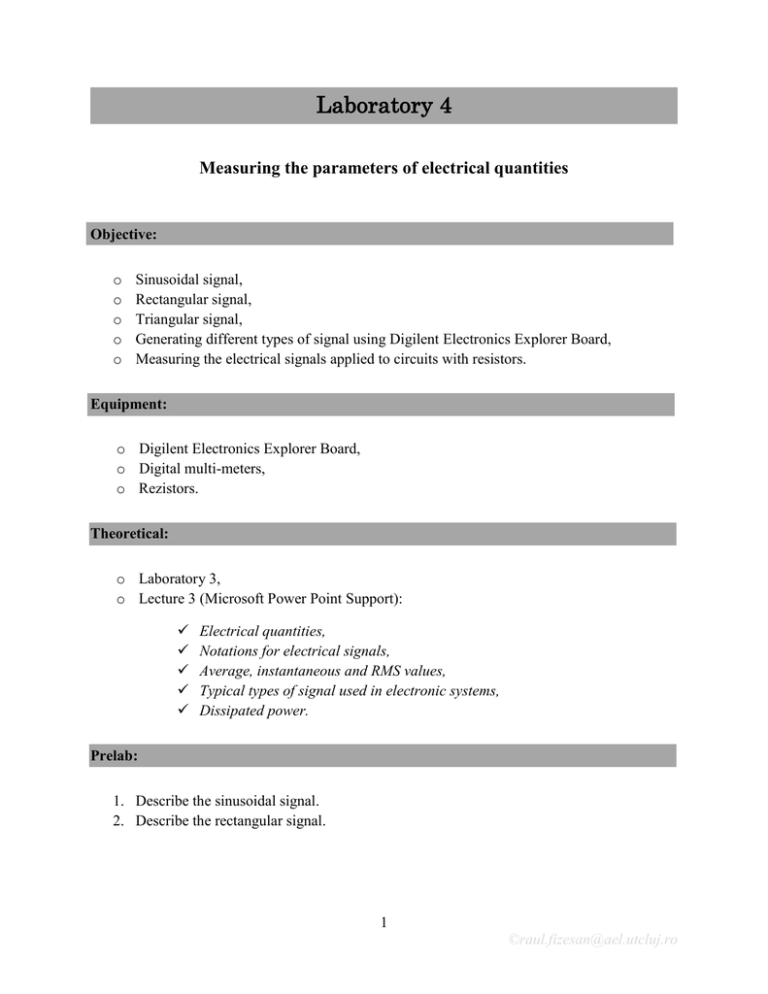
Laboratory 4
Measuring the parameters of electrical quantities
Objective:
o
o
o
o
o
Sinusoidal signal,
Rectangular signal,
Triangular signal,
Generating different types of signal using Digilent Electronics Explorer Board,
Measuring the electrical signals applied to circuits with resistors.
Equipment:
o Digilent Electronics Explorer Board,
o Digital multi-meters,
o Rezistors.
Theoretical:
o Laboratory 3,
o Lecture 3 (Microsoft Power Point Support):
Electrical quantities,
Notations for electrical signals,
Average, instantaneous and RMS values,
Typical types of signal used in electronic systems,
Dissipated power.
Prelab:
1. Describe the sinusoidal signal.
2. Describe the rectangular signal.
1
©raul.fizesan@ael.utcluj.ro
Procedure:
For the circuit shown in Fig.1, are given: R1=2.2kΩ, R2=1kΩ:
vR1(t)
vi(t)
vR2(t)
Fig.1
A) At the input of the circuit, is applied a signal described by the expression:
𝑣𝑖 (𝑡) = 2 sin(785𝑡), [V].
a. Implement the circuit presented in Fig.1 on the Digilent Explorer Board.
b. Set the module WaveGen to generate the sinusoidal signal vi(t) applied to the
input.
c. View signals vi(t), vR1(t), and vR2(t) using the Oscilloscope module.
d.
d.1. Measure the period of the signal vi(t) and compare this value with the
value set at b.
d.2. Measure values of the period for the signals vR1(t), and vR2(t) and compare
these values with the value of the signal period vi(t). Explain any
difference between these values.
e.
e.1. Measure the effective value of the variable component of the signals vi(t),
vR1(t), and vR2(t) using the Oscilloscope Module. Record these values in
Table 1 (Appendix 1).
e.2. Repeat the measurements using a Multi-Meter. Record the results of these
measurements in Table 1 (Appendix 1).
e.3. Calculate the amplitude of the variable components of the three signal
using the measurements obtained previously (e.1, e.2).
e.4. Compare the amplitude values of the variable component of the signal vi(t)
calculated at the step e.3 with the value set in the module WaveGen.
Explain any difference between these values.
2
©raul.fizesan@ael.utcluj.ro
f.
f.1. Measure the amplitude of the variable component of the signals vi(t),
vR1(t), and vR2(t). Record these values in Table 1 (Appendix 1).
f.2. Compare the measured values with the values calculated in section e.3.
Explain any difference between these values.
g.
g.1. Measure the average value of the signals vi(t), vR1(t), and vR2(t). Record
these values in Table 1 (Appendix 1).
g.2. Repeat the measurements using a multimeter. Record the results of these
measurements in Table 1 (Appendix 1).
g.3. Set the average value to 1V. Repeat steps g.1.-g.2. Compare the average
value measured of the signal vi(t) by the value set and explain any
difference between these values.
B) Set the module WaveGen to generate a rectangular signal given by the expression:
−1V,
𝑡 ∈ [𝑝𝑇; 𝑝𝑇 + 𝑘]
𝑣𝑖 (𝑡) = {
,
𝑝 ∈ 𝑍,
𝑇 = 8𝑚𝑠
3V, 𝑡 ∈ [𝑝𝑇 + 𝑘𝑇; (𝑝 + 1)𝑇]
a. Repeat steps a to g of section A.
Questions for Lab Report:
1. Explain the difference between the measured values and calculated values.
2. The signal from the following figure is given:
vi(t)
5.0V
4.0V
3.0V
2.0V
1.0V
0V
t
-1.0V
-2.0V
-3.0V
-4.0V
-5.0V
0s
10us
V(V1:+)
30us
50us
70us
90us
Fig.2
Time
a. Write the analytical expression of the signal.
b. Calculate the period and the frequency of the signal.
3
©raul.fizesan@ael.utcluj.ro
c. Determine the amplitude of the signal.
d. Determine the average value of the signal.
e. Determine the effective value of the variable component.
3. The following expression is given:
𝑣𝑖 (𝑡) = −1 + 4 sin(2π ∙ 250𝑡), [V]
a.
b.
c.
d.
e.
f.
Calculate the period and the frequency of the signal.
Determine the amplitude of the signal.
Determine the average value of the signal.
Determine the effective value of the variable component.
Plot the signal.
Consider the following oscilloscope settings.
y
y
x
x
y=0.5V
y=2V
x=0.4ms
x=2ms
Plot the signal in both cases.
4
©raul.fizesan@ael.utcluj.ro
Appendix 1
Sinusoidal signal
Table 1
vR1(t), [V]
vR2(t), [V]
Rectangular signal
vi(t), [V]
vR1(t), [V]
Calculated
V
(amplitude)
Measured
(Oscilloscope)
Measured
(Multimeter)
Calculated
Vo
(effective value)
Measured
(Oscilloscope)
Measured
(Multimeter)
Calculated
VO
(average value)
Measured
(Oscilloscope)
Measured
(Multimeter)
5
©raul.fizesan@ael.utcluj.ro
vR2(t), [V]
vi(t), [V]
